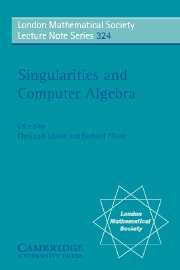Book contents
- Frontmatter
- Contents
- Preface
- Invited Lectures
- List of Participants
- Aspects of Gert-Martin Greuel's Mathematical Work
- Exterior Algebra Methods for the Construction of Rational Surfaces in the Projective Fourspace
- Superisolated Surface Singularities
- Linear Free Divisors and Quiver Representations
- Derived Categories of Modules and Coherent Sheaves
- Monodromy
- Algorithmic Resolution of Singularities
- Newton Polyhedra of Discriminants: A Computation
- Depth and Differential Forms
- The Geometry of the Versal Deformation
- 21 Years of SINGULAR Experiments in Mathematics
- The Patchworking Construction in Tropical Enumerative Geometry
- Adjunction Conditions for One-Forms on Surfaces in Projective Three-Space
- Sextic Surfaces with Ten Triple Points
- Sextic Surfaces with 10 Triple Points
- Topology, Geometry, and Equations of Normal Surface Singularities
The Patchworking Construction in Tropical Enumerative Geometry
Published online by Cambridge University Press: 11 November 2009
- Frontmatter
- Contents
- Preface
- Invited Lectures
- List of Participants
- Aspects of Gert-Martin Greuel's Mathematical Work
- Exterior Algebra Methods for the Construction of Rational Surfaces in the Projective Fourspace
- Superisolated Surface Singularities
- Linear Free Divisors and Quiver Representations
- Derived Categories of Modules and Coherent Sheaves
- Monodromy
- Algorithmic Resolution of Singularities
- Newton Polyhedra of Discriminants: A Computation
- Depth and Differential Forms
- The Geometry of the Versal Deformation
- 21 Years of SINGULAR Experiments in Mathematics
- The Patchworking Construction in Tropical Enumerative Geometry
- Adjunction Conditions for One-Forms on Surfaces in Projective Three-Space
- Sextic Surfaces with Ten Triple Points
- Sextic Surfaces with 10 Triple Points
- Topology, Geometry, and Equations of Normal Surface Singularities
Summary
Abstract
We prove two new patchworking theorems which describe deforma- tions of algebraic curves inscribed into a family of algebraic surfaces such that the central surface is reducible and a general surface is irreducible. These theorems justify all known applications of tropical geometry to the enumeration of real and complex nodal curves on toric surfaces. They may serve for similar applications to the enumeration of curves with more complicated singularities. In addition, using the patchworking techniques, we classify certain planar deformations of non-planar curve singularities which appear as an element of the tropical approach to the enumeration of curves on surfaces.
Introduction
The rapid development of tropical algebraic geometry over the last years has led to interesting applications of singular algebraic curves in enumerative geometry, proposed by Kontsevich (see [6]). The first result in this direction has been obtained by Mikhalkin [7, 8], who counted curves with a given number of nodes on toric surfaces via lattice paths in convex lattice polygons. It has further been applied to the enumeration of real rational curves on Del Pezzo surfaces [3, 4, 16] and of complex rational curves in higher-dimensional toric varieties [9]. Patchworking naturally appears as a part of the tropical approach to enumerative geometry [8, 15, 16]. In our treatment of the patchworking, we follow the version of [15, 16].
- Type
- Chapter
- Information
- Singularities and Computer Algebra , pp. 273 - 300Publisher: Cambridge University PressPrint publication year: 2006
- 4
- Cited by



